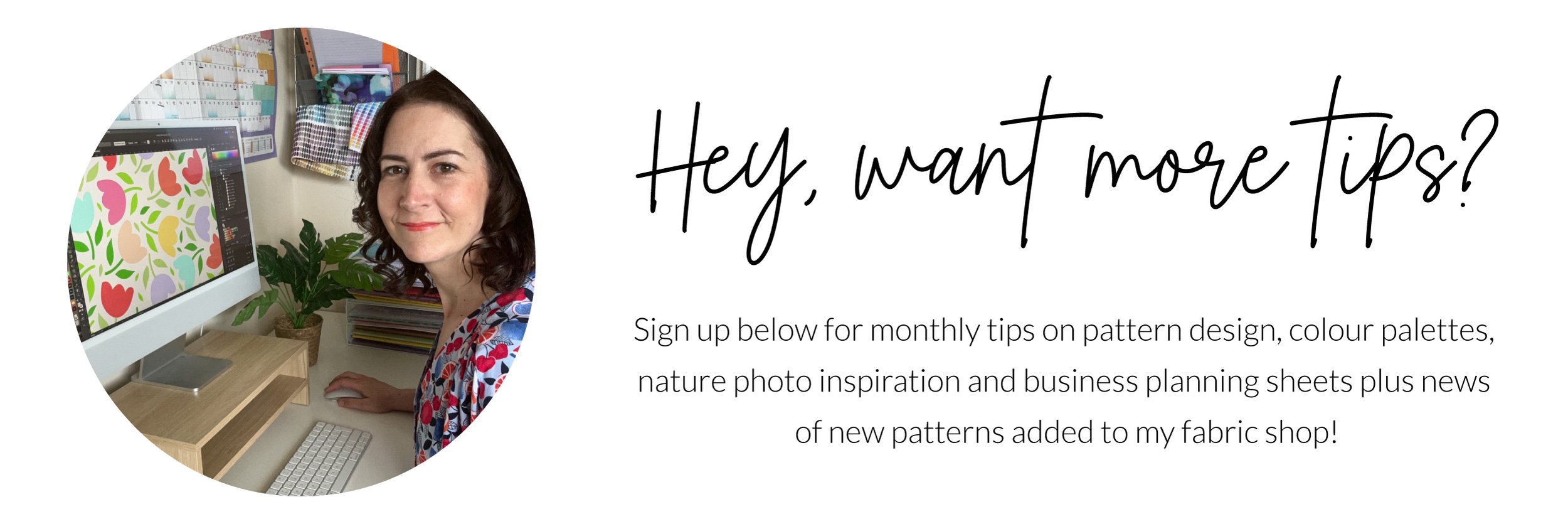A Cool easy way to Analyse Patterns
There are many, many patterns out in the world and as a beginner to the world of surface Pattern Design it can seem overwhelming! I feel you. I know that feeling well. When I started out creating patterns, I would see cool patterns and think ‘how did they create such a great pattern? what is it that makes it great?’. In today’s blog post, I share an easy way to analyse patterns that will get you seeing them much more clearly.
So how do we analyse patterns in a way that can help you?
I designed a record sheet that details the main things you need to look at when analysing patterns. Essentially you’re recordng the key information about a pattern and simply writing it down.
When looking at a pattern you need to take note of key things like:
colours used (colour palette)
how many motifs are used
what the motifs are (i.e floral, dinosaurs, leaves, butterflies, boats etc)
how big the motifs are
the variation in size of motifs
the style of the motifs (i.e rough drawn/edges, hand painted, watercolour, clean vector shapes etc)
line work used (i.e dashed lines, zig zag, wavy, dots, cross hatching etc)
After collecting this key information, you can use it to help you when designing a pattern or collection around a particular theme. For example, if I used the record sheet to analyse a boys dinosaur pattern, I might note things such as 10 different dinosaurs, eggs, bushes, trees, stones, foot prints, leaves etc.
Once I’ve collected this information, I would select a different pattern to analyse and do the same thing. Once I’ve analysed about 6-8 patterns (you can do as many as you wish) I have a good undersatnding of what to include in a pattern as well as key motif icons to draw. Obviously you can add other motifs to your patterns, but you have key information of what ‘makes’ that particular theme stand out and what most Art Directors would be looking for when using your artwork for their products.
My best advice would be:
research what’s out in the market now, whether going into high street stores or researching online, it doesn’t matter, just that you see what has made it to the shops and is available to buy now. It will show you what companies are looking for in their designers work so you have a better chance of getting your work used.
Note: I HIGHLY recommend you complete several record sheets for each theme you’re analysing so you get a good idea of variation on a particular theme and not just analyse one pattern from one designer.
So, let’s analyse one of my Autumn patterns so I can show you how easy this technique is!
4 Easy Steps
1.Select a pattern to analyse
2.Get you record sheet to hand (you can download my copy by signing up to my newsletter below)
3.Get the pattern next to your record sheet and really look at the pattern and write down everything you notice about it
4.Repeat this process several times and file your sheets away safely!
They will be really useful in the future when you’re designing a pattern, and can easily look at your sheets to remind yourself on what motifs you need to draw, what colour palette would be a good choice, how big to draw the motifs etc.
So, first up let’s look at a pattern of mine shown below
You will notice key things about it such as:
Traditional autumn colours used (brown-grey, yellow, orange, red, cream, white)
Only 2 main motifs used - leaf and berries
Size - leaves bigger, berries smaller
Clean vector shapes
White background makes motifs stand out
Line details on leaves, although simple details
The information from this pattern would be files under your ‘Autumn/Seasonal’ patterns and be really useful when designing patterns for this type of theme.
Write down as much info as you can as it will come in handy when your next drawing up your motifs for patterns.
This technique really is that simple! You can design your own record sheet or download a copy of the one I use below. Sign up to my newsletter to get your hands on it straightaway!
I hope you’ve found this technique useful :)
Related posts you may like:








Starting out in surface pattern design can feel overwhelming! Tools you still need to learn, patterns that don’t quite work and constant second-guessing yourself. Every designer starts here. The learning curve isn’t a setback, it’s part of your growth. In this post, we’ll explore how to recognise your progress and celebrate how far you’ve already come.